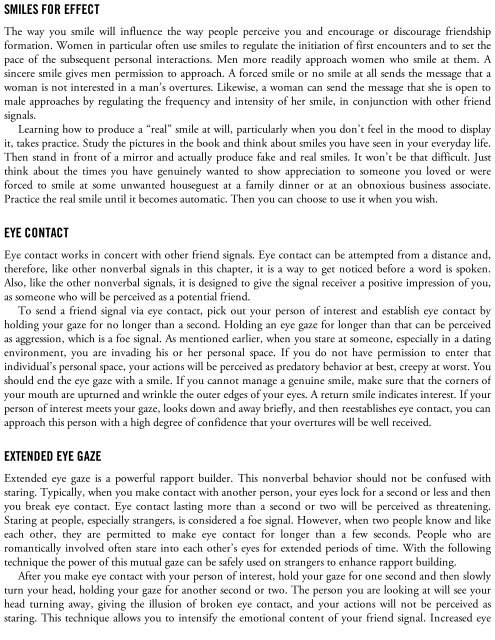[DR_The_Like_Switch
You also want an ePaper? Increase the reach of your titles
YUMPU automatically turns print PDFs into web optimized ePapers that Google loves.
SMILES FOR EFFECT<br />
<strong>The</strong> way you smile will influence the way people perceive you and encourage or discourage friendship<br />
formation. Women in particular often use smiles to regulate the initiation of first encounters and to set the<br />
pace of the subsequent personal interactions. Men more readily approach women who smile at them. A<br />
sincere smile gives men permission to approach. A forced smile or no smile at all sends the message that a<br />
woman is not interested in a man’s overtures. <strong>Like</strong>wise, a woman can send the message that she is open to<br />
male approaches by regulating the frequency and intensity of her smile, in conjunction with other friend<br />
signals.<br />
Learning how to produce a “real” smile at will, particularly when you don’t feel in the mood to display<br />
it, takes practice. Study the pictures in the book and think about smiles you have seen in your everyday life.<br />
<strong>The</strong>n stand in front of a mirror and actually produce fake and real smiles. It won’t be that difficult. Just<br />
think about the times you have genuinely wanted to show appreciation to someone you loved or were<br />
forced to smile at some unwanted houseguest at a family dinner or at an obnoxious business associate.<br />
Practice the real smile until it becomes automatic. <strong>The</strong>n you can choose to use it when you wish.<br />
EYE CONTACT<br />
Eye contact works in concert with other friend signals. Eye contact can be attempted from a distance and,<br />
therefore, like other nonverbal signals in this chapter, it is a way to get noticed before a word is spoken.<br />
Also, like the other nonverbal signals, it is designed to give the signal receiver a positive impression of you,<br />
as someone who will be perceived as a potential friend.<br />
To send a friend signal via eye contact, pick out your person of interest and establish eye contact by<br />
holding your gaze for no longer than a second. Holding an eye gaze for longer than that can be perceived<br />
as aggression, which is a foe signal. As mentioned earlier, when you stare at someone, especially in a dating<br />
environment, you are invading his or her personal space. If you do not have permission to enter that<br />
individual’s personal space, your actions will be perceived as predatory behavior at best, creepy at worst. You<br />
should end the eye gaze with a smile. If you cannot manage a genuine smile, make sure that the corners of<br />
your mouth are upturned and wrinkle the outer edges of your eyes. A return smile indicates interest. If your<br />
person of interest meets your gaze, looks down and away briefly, and then reestablishes eye contact, you can<br />
approach this person with a high degree of confidence that your overtures will be well received.<br />
EXTENDED EYE GAZE<br />
Extended eye gaze is a powerful rapport builder. This nonverbal behavior should not be confused with<br />
staring. Typically, when you make contact with another person, your eyes lock for a second or less and then<br />
you break eye contact. Eye contact lasting more than a second or two will be perceived as threatening.<br />
Staring at people, especially strangers, is considered a foe signal. However, when two people know and like<br />
each other, they are permitted to make eye contact for longer than a few seconds. People who are<br />
romantically involved often stare into each other’s eyes for extended periods of time. With the following<br />
technique the power of this mutual gaze can be safely used on strangers to enhance rapport building.<br />
After you make eye contact with your person of interest, hold your gaze for one second and then slowly<br />
turn your head, holding your gaze for another second or two. <strong>The</strong> person you are looking at will see your<br />
head turning away, giving the illusion of broken eye contact, and your actions will not be perceived as<br />
staring. This technique allows you to intensify the emotional content of your friend signal. Increased eye


